IoTaWatt doesn't advertise.
This google ad from Amazon is simply a lie. IoTaWatt doesn't advertise or sell anywhere other than our web store, where believe it or not you can still get free two-day shipping east
of the Mississippi. We rely on word of mouth from satisfied users., and that word is spreading. That's probably why Amazon feel it needs to co-opt our trademark to sell their products. How can IoTaWatt be any good if it's
not the top ad placement on google? the "Amazon Choice"? the selection of the x vs y energy monitor comparison website? Consider that it might be the other way around. That IoTaWatt and yes, some others, are really
better at energy monitoring and just not as good at saturating the market with advertising and bold claims. It's not the sizzle, it's the steak.
The major advertising juggernaut makes a lot of claims about detailing your energy use but take a look at their customer reviews on Amazon. They tell a different story. Makes you wonder exactly what the "Amazon Choice" is based on. It has a nice app that plays like a video game if you need a running commentary about when your toaster goes on and off. If you want to seriously sit down and see where your energy is actually going, IoTaWatt may be a better choice.
Call me old fashioned, but when I drop $300 on something that claims to help me save energy, I don't expect to have to identify my appliances to help it learn over weeks and months to identify them. I expect on day one it will start teaching me about my energy use and providing accurate detailed information. You already know your whole house uses a lot of energy, that's the bottom line of your monthly bill, what you need is a reliable breakdown to actually manage your energy dollar. It's no wonder that IoTaWatt is the monitor of choice for many energy professionals.
Open system, private data.
It's not that other energy monitors are bad, but they are different in that they are mostly closed systems that provide limited data and require that you use their cloud and phone app platforms. IoTaWatt collects many more metrics and stores that usage history locally. With it's integrated web-server you can manage setup, view real-time status or create detailed graphs using the browser on your computer, tablet or phone. It's your data, in your own home, and subject only to your own privacy and retention policy. You don't need the cloud to get a handle on your hot-tub, EV, solar or heat-pump.
IoTaWatt can, however, easily upload usage data to any of several third party databases with associated apps and analytic tools. For instance PVoutput is a free service that connects easily with IoTaWatt and provides world-class solar energy analytics. There is full support for uploading to influxDB. There is also an API interface for those who want to query data for their own applications or to use in spreadsheets, and there are integrations available for home automation software like Home Assistant.
A universal solution.
IoTaWatt is probably the only monitor in it's class that can literally be used to monitor any power system. It is in use in over 60 countries worldwide. USA split-phase 120V/240V is easy, but also 230V single-phase as in Europe, 230V three-phase as in homes in Australia, Germany and norway to name a few. Most folks only care if it will work in their situation. The answer is an unqualified yes.
There are also many commercial/industrial users monitoring high voltage three-phase systems including 277V/480V industrial with 600Amp service using several megaWatt-hours per day - more than most households use in a year. Then there's a site in Uganda measuring voltage and power used to charge rental electric motorcycles using Solar Energy.
This is all possible because IoTaWatt uses simple external sensors that are available for any and all voltage/power combinations. Just install, plug into the IoTaWatt and select the sensor type from a dropdown menu in the configuration app.

How it Works
IoTaWatt measures each circuit using a passive sensor that clips around one of the insulated wires. The output of each of these current-transformers is very low-voltage and plugs into any one of IoTaWatt's 14 inputs.
A wall transformer inserted into an ordinary receptacle converts local voltage to a standard reference voltage and allows IoTaWatt to determines line voltage and frequency.
From the browser based configuration app, you simply select the model sensor that is connected. IoTaWatt knows how to interpret the signals to produce a highly accurate measure of the power being used at any moment.
Measures 14+ circuits
Standard stereo jacks make connecting the current sensors a breeze. Each of the 14 inputs is typically one current-transformer measuring one circuit, but a single input can be used to monitor multiple circuits, and/or several CTs can be combined into a single input.
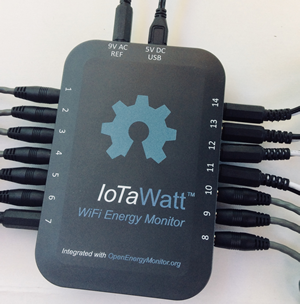
Intuitive Configuration
All of the inputs are listed with name, sensor type, and various options. To edit, click on the input number.
.png)
Change the name, or specify a different sensor model from the dropdown list. Save and IoTaWatt begins using the new configuration immediately.
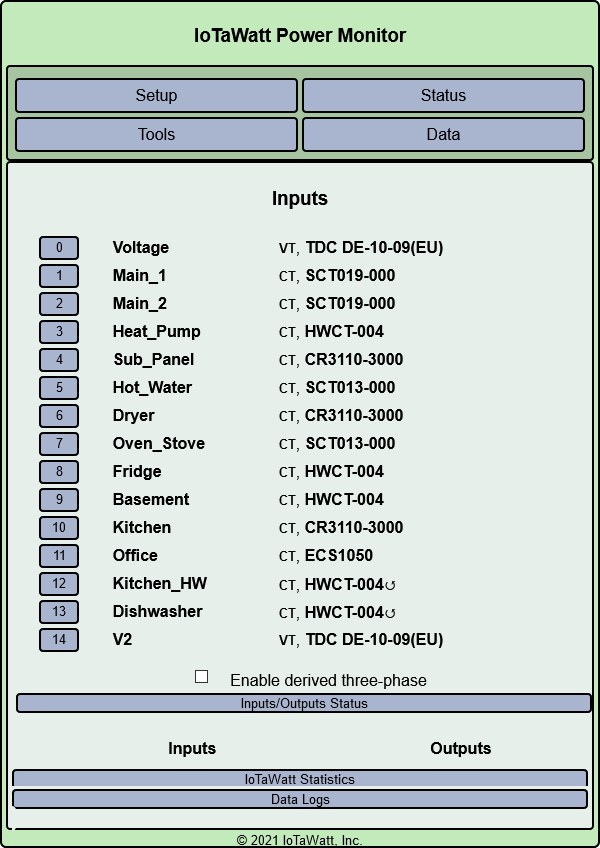
Comprehensive Status Display
The status of inputs and outputs is updated continuously. Outputs can be defined to make additional details available. The status of server uploads and context of the data-logs is available in drop-down tabs.

Integrated Analytic Tools
Integrated analytic tools allow viewing usage graphically. Show total power use along with individual circuits by selecting from a menu.
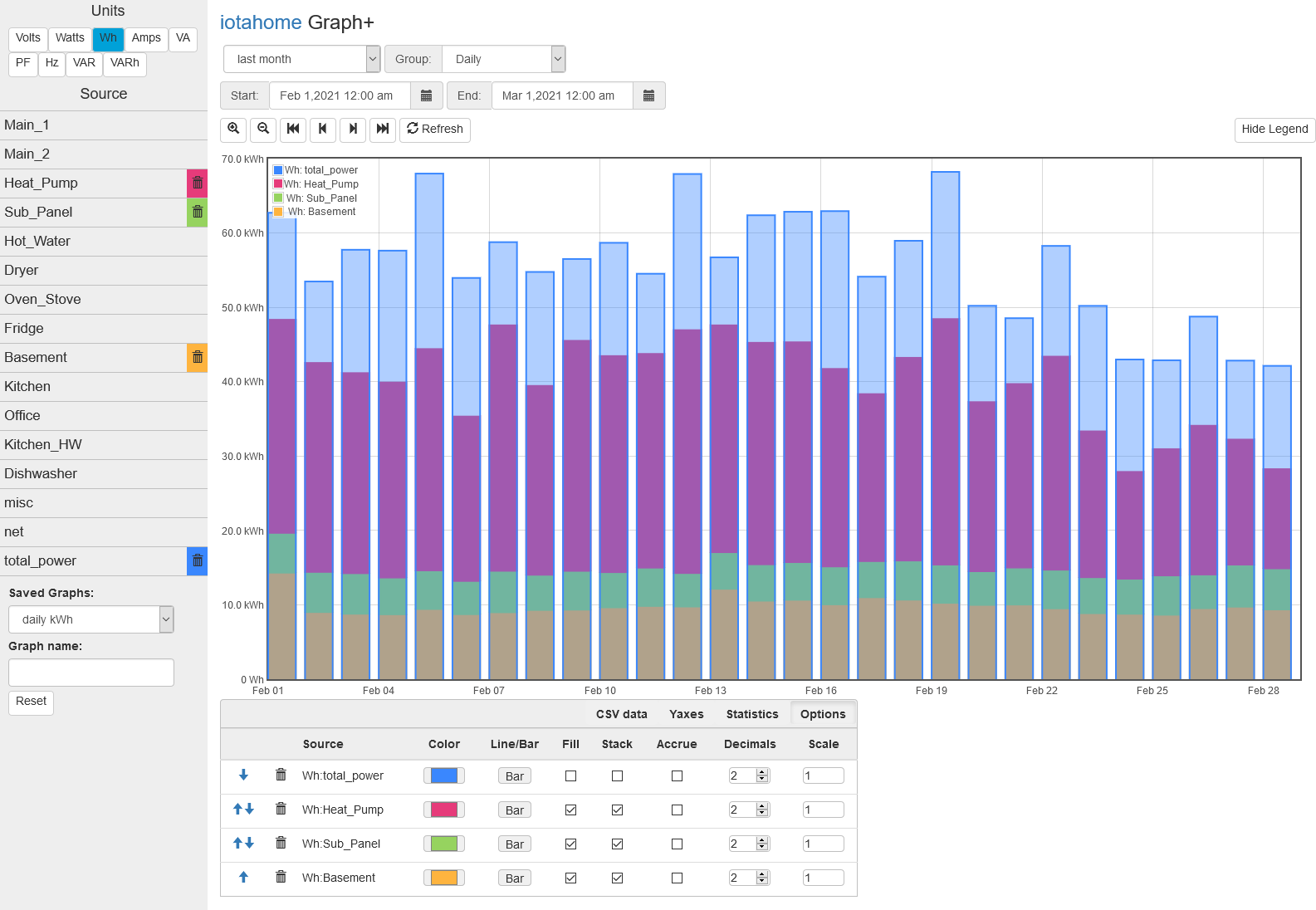
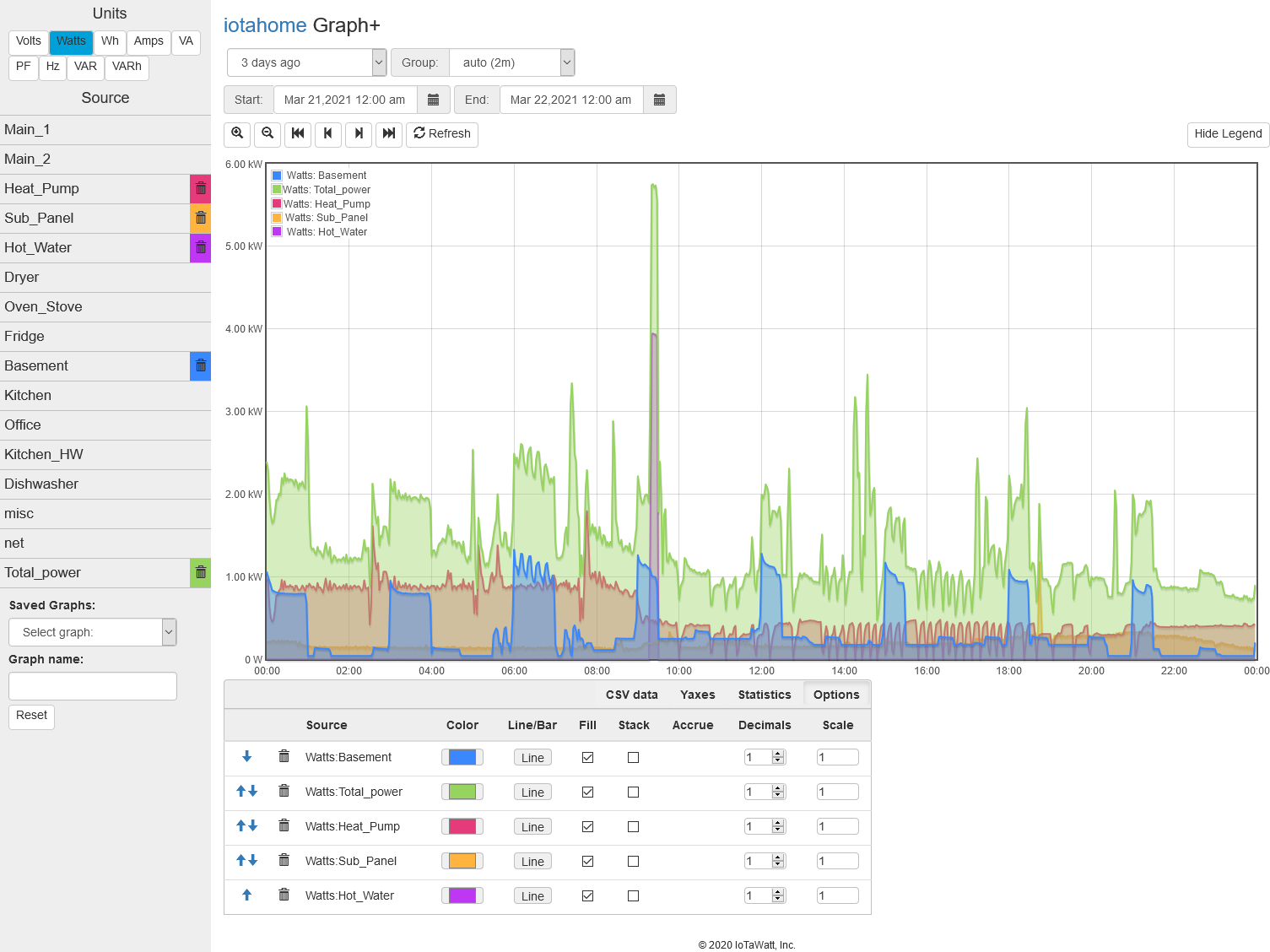
The Graph+ app runs directly from IoTaWatt's web server. It can be used from a PC, phone or tablet.
Uploads to influxDB and Emoncms
More sophisticated users can configure data upload to influxDB and use Grafana or one of several other visualization tools to create stunning dashboards.
There is also an option to upload to the Emoncms system with it's own integrated graphical tools.

Emoncms dashboard

grafana dashboard with influxDB data source
Both of these external databases are open-software and available as commercial services or hosted on various personal platforms including windows and RaspberryPi.
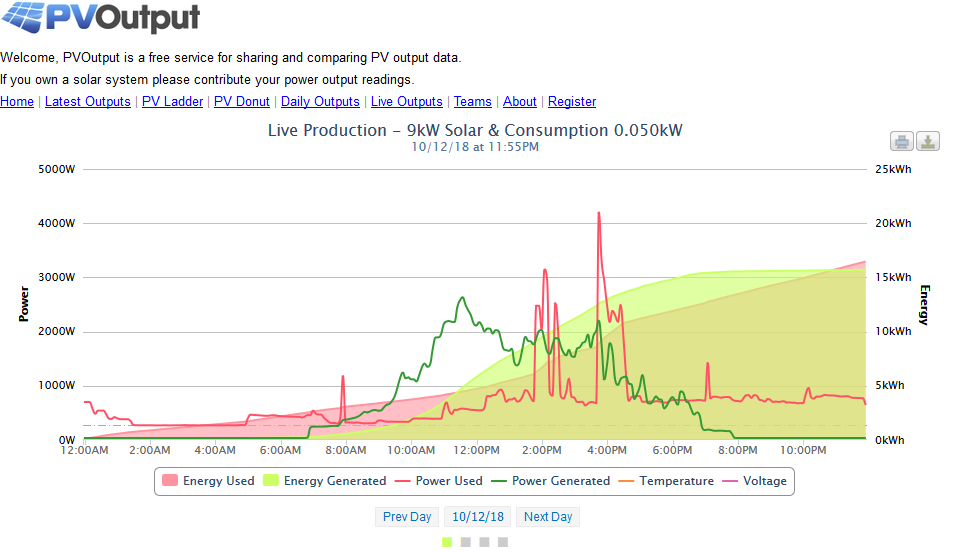
PVoutput live-status display
Uploads to PVoutput
PVOutput is a free online service for sharing and comparing photovoltaic solar panel output data.
Output data can be graphed, analysed and compared with other pvoutput contributors over various time periods.
While
pvoutput is primarily focused on monitoring energy generation, it also provides equally capabable facilities to upload and monitor energy consumption data. Both solar generation and energy consumption data can be combined
to
provide a 'Net' view of energy being either generated or consumed live.
Simple Powerful Scripting
The "calculator" is IoTaWatt's simple interface for creating scripts to combine and export data. You specify the units to calculate (Amps, Watts, Volts etc.) and then enter the function to calculate the value. It's as easy
as using a basic four-function calculator.
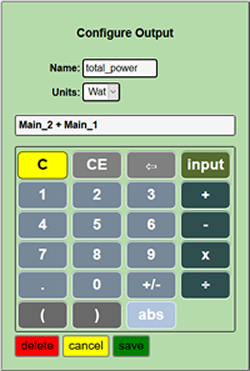
Three Phase Capability
IoTaWatt can handle three-phase power in several ways. The easy way uses just one voltage/phase reference transformer plugged into any of the three-phases. Power measurements on the two other phases are made using a "derived" three-phase reference signal.
For utmost accuracy, two additional transformers can be connected to inputs for "direct" voltage and phase reference of all phases.
Fully Certified
IoTaWatt has been tested for compliance with regulatory and safety standards of North America and Europe including:
- Compliance with FCC part B
- CE compliance including Radio Emissions Directive (RED) and Low-voltage Directive
- Low-voltage safety standards for US (UL) and Canada (CSA). Testing and certification by Intertek and bears the ETL certification mark.
- Accessories sold by IoTaWatt, Inc are UL listed or UL recognized and listed for use with IoTaWatt.
